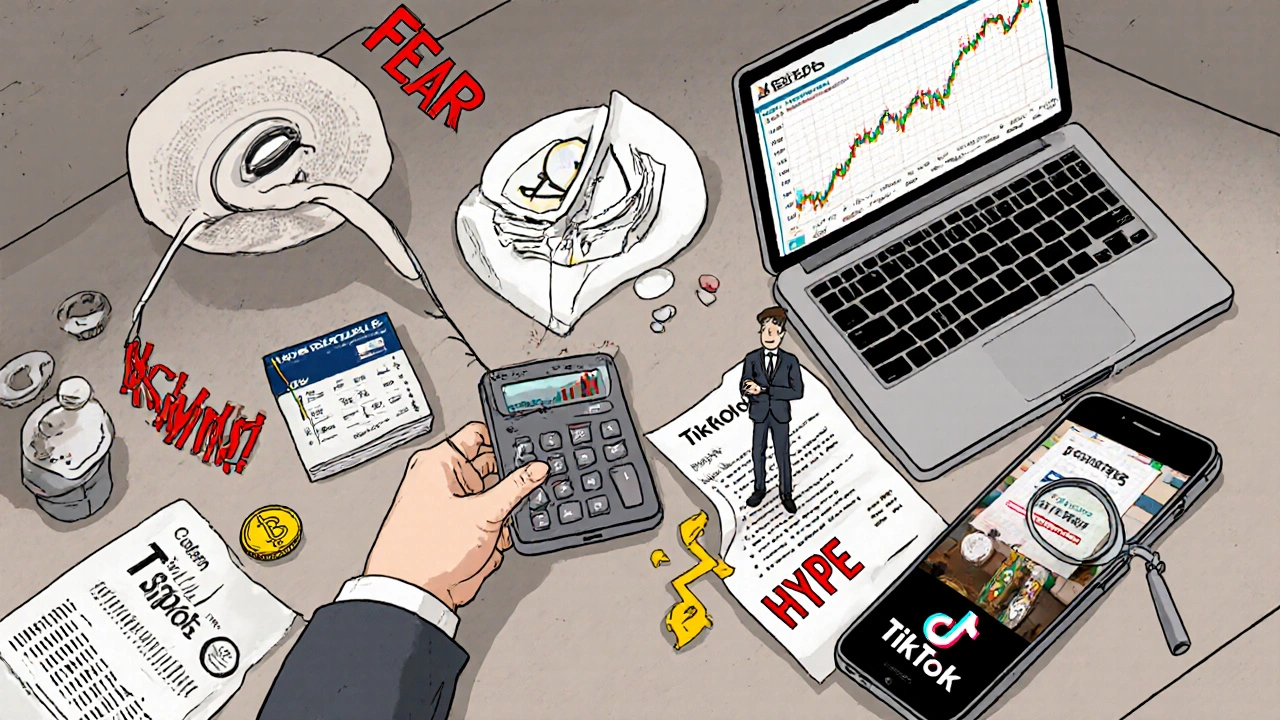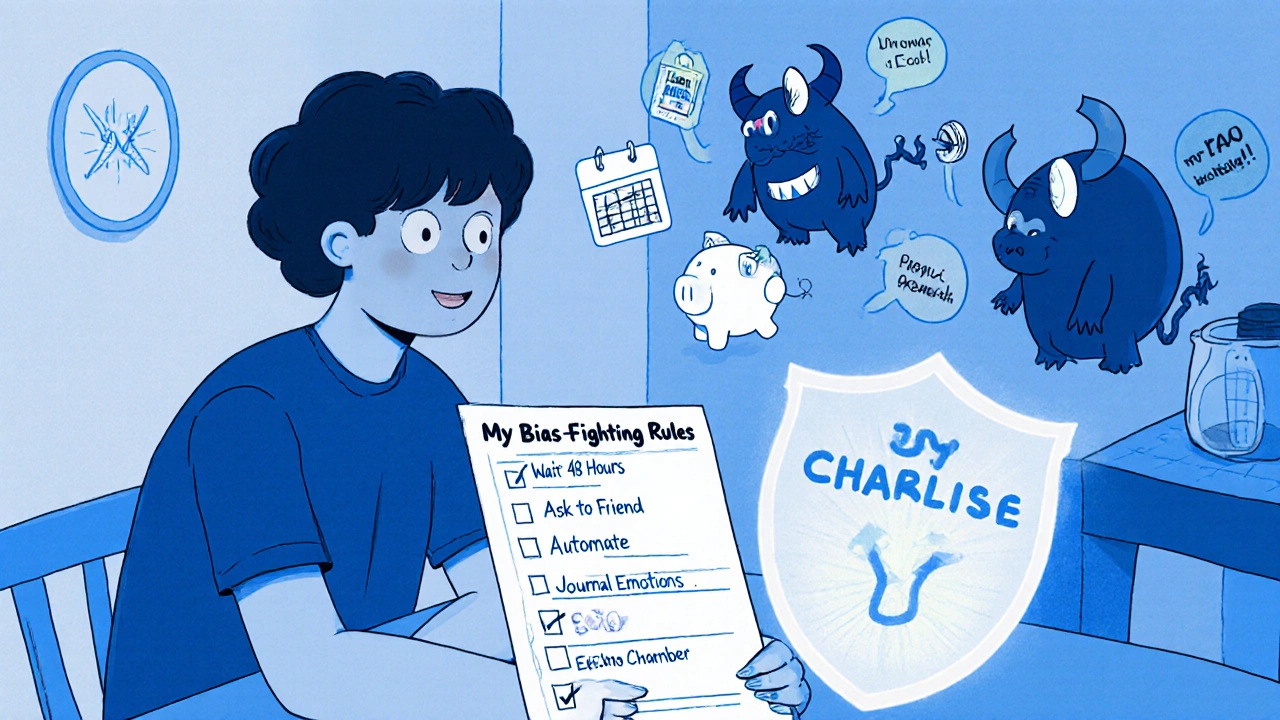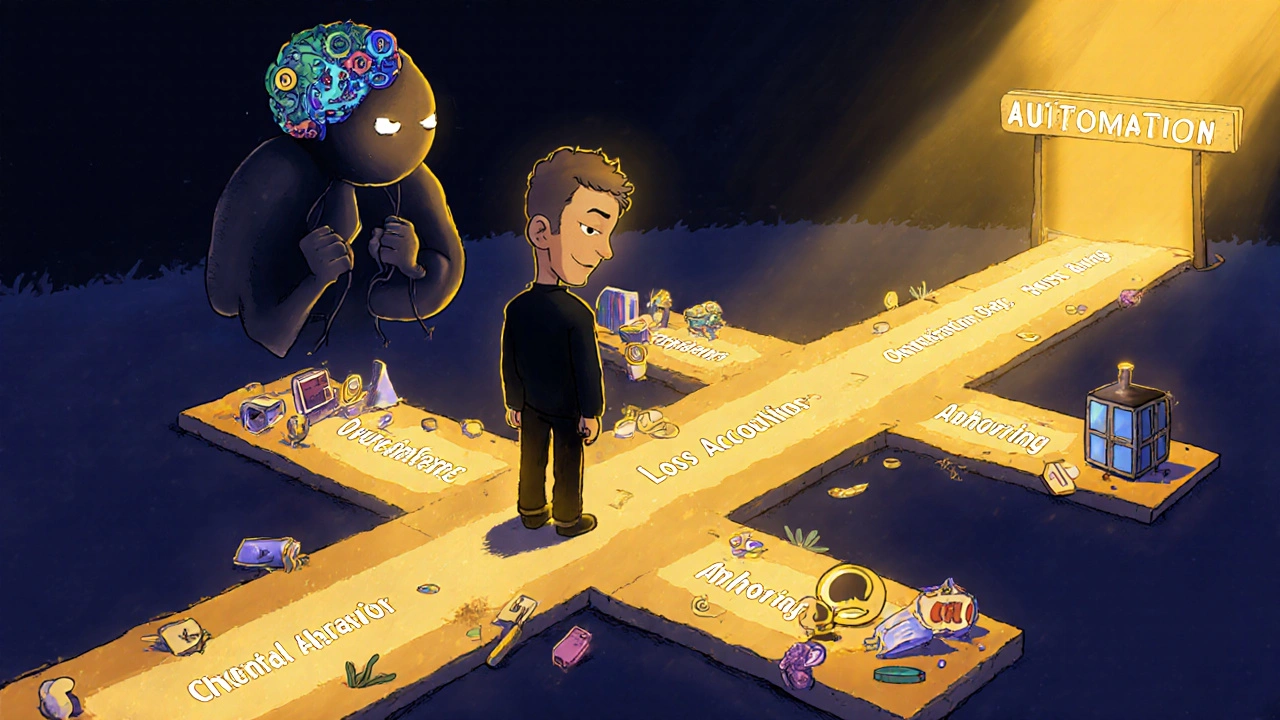Most people think they make smart money decisions. But if you look at real behavior - not what people say they do - you’ll see a different story. People hold onto losing stocks too long. They chase hot stocks after they’ve already spiked. They keep cash in low-interest savings while paying 20% interest on credit cards. These aren’t mistakes from ignorance. They’re mistakes from behavioral finance biases - invisible mental shortcuts that trick your brain into making bad financial calls.
Why Your Brain Sabotages Your Money
Traditional economics assumes people are rational. You weigh risks, compare options, and pick the best outcome. But real humans don’t work that way. In the 1970s, psychologists Daniel Kahneman and Amos Tversky proved it. Their Prospect Theory showed that people feel the pain of losing money about 2.25 times more than the joy of gaining the same amount. That single insight changed how we understand money decisions. It’s not about logic. It’s about emotion, memory, and fear. These biases aren’t rare. They’re universal. A Vanguard study of 1.3 million investor accounts found that behavioral mistakes cost people 1.5% to 2.0% in annual returns - roughly $1,500 to $2,000 per year on a $100,000 portfolio. Over 10 years, that’s tens of thousands lost. And it’s not just amateurs. Even financial advisors fall for these traps.Overconfidence Bias: Thinking You Know More Than You Do
You’ve probably said something like: “I picked this stock because I understand the company.” Or: “I know when to get in and out.” That’s overconfidence bias - and it’s one of the most expensive mistakes you can make. A 2022 study found investors believe their judgment is 25% more accurate than it actually is. That leads to excessive trading. Barber and Odean’s landmark study of 66,465 households showed that the most active traders earned 2.4% less per year than the least active ones. Why? Because they bought high and sold low - often after reading a headline or seeing a friend’s post on social media. Real-world example: A man in Ohio bought shares of a tech startup after reading a Reddit thread. He traded 17 times in three months. His portfolio lost 18%. He didn’t lose because the stock was bad. He lost because he acted on feeling, not data. How to fix it:- Limit how often you check your portfolio - once a quarter is enough.
- Ask yourself: “Would I buy this same stock if I didn’t already own it?”
- Use automated investing tools. They don’t get emotional.
Loss Aversion: Holding Onto Losers Too Long
You bought Tesla at $700. It dropped to $450. You won’t sell. Why? Because selling means admitting you made a mistake. That sting of loss feels worse than the potential gain of moving your money elsewhere. Kahneman and Tversky’s research showed that losing $100 hurts more than gaining $100 feels good. That’s why 37% of investors hold losing positions longer than winning ones, according to Charles Schwab’s 2021 analysis. They’re not waiting for a rebound - they’re avoiding pain. This isn’t just about stocks. It’s about houses, cars, even subscriptions. You keep paying for a gym membership you never use because “I already paid for it.” That’s the sunk cost fallacy - a cousin of loss aversion. Real-world example: A woman in Atlanta held onto a rental property that lost money for six years. She refused to sell because she “didn’t want to take the loss.” When she finally sold, she lost $45,000. The market had already moved on. How to fix it:- Set stop-loss rules before you buy. Example: “If this drops 15%, I sell.”
- Write down your original reason for buying. If that reason is gone, it’s time to move on.
- Use a “fresh eyes” rule: Ask a trusted friend to review your holdings without knowing your purchase price.
Mental Accounting: Treating Money Differently Based on Where It Comes From
You treat $1,000 from your bonus differently than $1,000 from your paycheck. You’ll spend the bonus on a vacation but save the paycheck. That’s mental accounting - and it’s irrational. The problem? Money is money. A dollar in your checking account has the same value as a dollar in your IRA. But your brain assigns emotional labels: “This is my fun money,” “That’s for retirement,” “This is my emergency fund.” A 2022 FINRA study found that 42% of Americans carry high-interest credit card debt while keeping money in savings accounts earning less than 1% interest. That’s like paying $200 a year in interest to earn $5 in savings. You’re not being careful - you’re being confused. Real-world example: A teacher in Michigan paid $2,800 in credit card interest last year. At the same time, she had $12,000 in a savings account earning 0.3%. She called it “my kids’ college fund.” But she never touched it. She just kept paying interest to avoid “touching” that money. How to fix it:- Consolidate accounts. Use one checking account for all income and expenses.
- Automate debt repayment. Set up auto-pay for credit cards before you get paid.
- Ask: “If I didn’t label this money, would I still treat it the same way?”

Anchoring: Letting the Past Dictate Your Present
You see a stock trading at $150. You remember it was $200 last year. So you think: “It’s on sale.” You buy it. But the $200 price? That’s just a number. It doesn’t mean anything now. That’s anchoring bias - your brain latches onto the first number you see and uses it as a reference point, even if it’s irrelevant. Research by Tversky and Kahneman showed it takes an average of 3.7 new data points to overcome an initial anchor. That’s why investors hold onto stocks after they’ve crashed, waiting for them to “get back to where they were.” Real-world example: A couple in Texas bought a house in 2020 for $420,000. In 2023, the market dropped. Their house was worth $370,000. They refused to sell, saying, “We’ll wait until we get our $420,000 back.” Two years later, it sold for $355,000. They missed the chance to cut losses and move to a better neighborhood. How to fix it:- Ignore past prices. Focus on current fundamentals: earnings, cash flow, market trends.
- Use objective benchmarks. Compare a stock to its industry average, not its own history.
- Write down your decision criteria before you act. Stick to it.
Herd Behavior: Following the Crowd Into Trouble
Everyone’s talking about crypto. Or AI stocks. Or meme stocks. You jump in. Why? Because you don’t want to miss out. Herd behavior fuels bubbles - and crashes. The GameStop surge in January 2021 wasn’t about fundamentals. It was about social media hype. Retail trading hit 24.6% of total market volume - up from 16.7% the year before. Thousands bought at the peak. Most lost money. A 2023 University of Chicago study found crypto investors show 3.2 times more overconfidence than traditional investors. That’s why Bitcoin swings 78% a year - while the S&P 500 swings 15%. People aren’t investing. They’re gambling with emotion. Real-world example: A 28-year-old in Austin invested $15,000 in Dogecoin after seeing a TikTok video. Three months later, it was worth $3,000. He didn’t sell because “everyone’s still talking about it.” He waited too long. How to fix it:- Ask: “Would I still buy this if no one else was?”
- Delay purchases. Wait 72 hours before acting on hype.
- Follow the rule: If it’s on TikTok, Reddit, or YouTube, it’s probably too late.
Confirmation Bias: Only Listening to What You Want to Hear
You think Apple is a great stock. So you read every article praising Apple. You ignore reports about slowing iPhone sales or supply chain issues. That’s confirmation bias - your brain filters out information that challenges your beliefs. A 2023 study found 68% of retail investors remember only positive news about stocks they own. This is dangerous because it creates blind spots. You think you’re being thorough. But you’re just being selective. Real-world example: A man in Florida invested in a renewable energy company because he believed in climate change. He ignored warnings about its debt load and management turnover. The stock lost 60% in a year. How to fix it:- Actively seek out opposing views. Read one negative article for every positive one.
- Keep an investment journal. Write down why you bought something - and update it when facts change.
- Ask your financial advisor: “What’s the worst thing that could happen to this investment?”

How to Fight Back - Practical Steps
You can’t eliminate biases. But you can reduce their power. Here’s how:- Use automation. Set up automatic contributions and rebalancing. You won’t be tempted to act on emotion.
- Get a second opinion. Talk to a fee-only financial planner - not a salesperson. Ask them to challenge your thinking.
- Delay decisions. Wait 48 hours before making any big move. Sleep on it.
- Track your behavior. Keep a simple log: “What emotion drove this decision?”
- Use tools. Platforms like Betterment and Vanguard’s behavioral coaching tools help you spot your own patterns.
Who’s Winning at This?
The people who win aren’t the smartest. They’re the most self-aware. Dr. Hersh Shefrin, a leading behavioral finance expert, found that investors who actively work to reduce their biases improve returns by 1.8% to 2.5% annually. That’s not a small gain. Over 10 years, it turns $100,000 into $130,000 - instead of $110,000. It’s not about predicting the market. It’s about controlling yourself.Final Thought
Money decisions aren’t about math. They’re about psychology. The best investor isn’t the one with the best tips. It’s the one who knows their own mind well enough to not trust it. Start small. Pick one bias. Watch for it this month. When you catch yourself acting on emotion - pause. Ask: “Is this logic - or just my brain playing tricks?” The money you save by not making one bad decision? It’s worth more than any stock tip.What are the most common behavioral finance biases?
The most common biases are overconfidence, loss aversion, mental accounting, anchoring, herd behavior, and confirmation bias. These cause people to trade too often, hold losing investments too long, ignore debt, fixate on past prices, follow trends blindly, and only seek information that supports their beliefs.
Can behavioral biases really cost me money?
Yes. Studies show behavioral mistakes cost the average investor 1.5% to 2.0% in annual returns. On a $100,000 portfolio, that’s $1,500 to $2,000 lost every year. Over 10 years, that adds up to $20,000 or more - not counting missed compounding.
Do financial advisors use behavioral finance?
Yes. As of 2022, 87% of wealth management firms use behavioral finance principles with clients. Many now offer behavioral coaching, automated tools, and decision-checklists to help clients avoid emotional mistakes. Even professional investors still struggle with anchoring and overconfidence.
How can I stop myself from making emotional money decisions?
Use automation: set up automatic investing and rebalancing. Delay big decisions for 48 hours. Keep an investment journal. Ask yourself: “Would I make this choice if I weren’t feeling anxious or excited right now?” Talk to a fee-only advisor who challenges your thinking - not just agrees with you.
Are millennials more prone to behavioral biases?
Millennials are 28% more likely to recognize their biases than baby boomers - but they’re also 35% more likely to fall for social media-driven herd behavior. That means they’re more aware but more easily influenced by online hype, especially around crypto and meme stocks.
Is behavioral finance just psychology, or does it work in real markets?
It’s both. Behavioral finance explains real market events - like the 2021 GameStop surge, crypto crashes, and housing bubbles. It’s not theory. It’s documented in data from millions of investor accounts. Firms like J.P. Morgan and BlackRock use AI tools to detect and correct behavioral patterns in real time. The SEC even lists these biases as key causes of retail investor losses.

Comments (3)
Laura W
Okay but like-have you seen the way my cousin trades crypto? She buys every coin after it 2x’s, then cries when it dumps. She calls it ‘FOMO investing’ like it’s a personality trait. Meanwhile she’s got $12k in a 0.2% savings account and a $9k credit card balance. Mental accounting is REAL. I told her to just move the cash to pay down debt and she said ‘but that’s my vacation fund’-like, honey, your vacation fund is literally paying you to suffer.
Graeme C
Let’s be unequivocally clear: behavioral finance isn’t a ‘nice-to-know’ framework-it’s the single most underutilized tool in retail investing. The notion that humans are rational actors is not merely flawed-it is catastrophically delusional. The 1.5–2% annual drag from cognitive biases isn’t a footnote; it’s the silent killer of retirement dreams. And the fact that even financial advisors succumb to anchoring and overconfidence? That’s not incompetence. That’s systemic human nature. Automation isn’t a workaround-it’s a necessity. If you’re manually rebalancing, you’re already losing. The market doesn’t care if you ‘feel’ like holding Tesla. It only cares if you’re wrong-and you will be.
Astha Mishra
It is truly fascinating, and perhaps a little heartbreaking, how deeply our emotional wiring interferes with what should be simple arithmetic. We are creatures of story, not statistics-our brains evolved to survive lions and famine, not to navigate 401(k)s and ETFs. I have watched my own mother, a brilliant woman who taught high school physics for 35 years, refuse to sell a stock that dropped 40% because ‘I don’t want to lock in the loss’-as if the market itself were judging her. The truth is, money doesn’t remember what you paid for it. Only we do. And that memory? It’s a trap. I’ve started writing down why I buy each asset-not just the ticker, but the feeling behind it. ‘Hope.’ ‘Fear.’ ‘Greed.’ ‘Regret.’ I’ve found that if I can name the emotion, I can usually step back before I act. It’s not about being smarter than the market. It’s about being kinder to yourself than your brain wants to be.